Acer Chromebook 314 (C933) review – what if your Android smartphone was a laptop
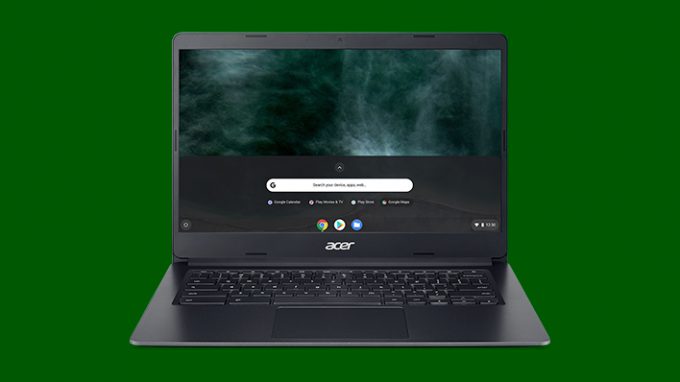 A Chromebook meant for working inside the office and out (at home as well). As a 14-inch laptop, the Acer Chromebook 314 (C933) has a big competition in the business market. Most of it comes from Windows-equipped devices, of course, but how exactly does the Chrome OS benefit (or hurt) its usability.
A Chromebook meant for working inside the office and out (at home as well). As a 14-inch laptop, the Acer Chromebook 314 (C933) has a big competition in the business market. Most of it comes from Windows-equipped devices, of course, but how exactly does the Chrome OS benefit (or hurt) its usability.
Essentially, you won’t be able to use the full-fledged Adobe Suit, nor any sophisticated 3D modeling software, but honestly, this is not what the Chromebook 314 (C933) is about. Even if you had the OS support for these programs, the low-power Intel Pentium Silver N5030 simply doesn’t have the punch. However, we know exactly what it is good at – browsing the web and office-related tasks. Exactly what a browser-based operating system needs.
Additionally, Acer promises a battery life, that should deliver more than 12 hours of usage. While this is highly subjective, and dependant on the workload you put it through, we are still going to show you some results later on. By the way, this is a laptop that unlike the Chromebook Spin 311, looks very modern, even in 2020, thanks to its slim bezels, and the design similarities it took from the Acer Swift 3 series.
You can check the prices and configurations in our Specs System: https://laptopmedia.com/series/acer-chromebook-314-c933/
Also, you can check the current price of Acer Chromebook 314 (C933) here: Buy from Amazon.com (#CommissionsEarned)
Contents
Specs Sheet
- HDD/SSD
- up to 128GB SSD
- RAM
- up to 8GB
- OS
- Chrome OS
- Battery
- 48Wh, 3-cell, 48Wh, 4-cell, 45Wh, 3-cell, 3-cell, 4-cell
- Dimensions
- 325.1 x 231.1 x 19.8 mm (12.80" x 9.10" x 0.78")
- Weight
- 1.70 kg (3.7 lbs)
- Ports and connectivity
- 2x USB Type-A
- 3.2 Gen 1 (5 Gbps)
- 2x USB Type-C
- 3.2 Gen 1 (5 Gbps), DisplayPort
- Card reader
- MicroSD
- Wi-Fi
- 802.11ac
- Bluetooth
- 5.0
- Audio jack
- 3.5 mm combo
- Features
- Fingerprint reader
- Web camera
- Backlit keyboard
- optional
- Microphone
- Speakers
- 2 Stereo Speakers
- Optical drive
- Security Lock slot
All Acer Chromebook 314 (C933) configurations
What’s in the box?
Well, inside the packaging, we found only the laptop, some manuals, and the 45W USB Type-C power brick.
Design and construction
Although the Chromebook is relatively thin at 19.8mm, it feels a little heavy due to the 1.70 kg weight, and a 14-inch chassis. Nevertheless, it is comfortable to carry around. To our feel, the entire body is made out of plastic, but yet a rather thick one. On the lid, you will see the Google Chrome logo, which is concaved and sits a little lower than the lid itself. While the colorful logo looks weird, we think that it is not that bad, especially paired with the Graphite color of the notebook.
Now, as far as the rigidity is concerned, there is some movement in the chassis, when twisting is applied. And apart from some minor squeaks, there is nothing to worry about. As of the lid, it cannot be opened with a single hand and when you try to twist it does move more than the body, but again – nothing to worry about. By the way, the camera is located in its traditional position above the display, which, respectively, has a matte finish and touchscreen support.
Then we continue to the keyboard deck, which looks surprisingly similar to the 11-inch Chromebook Spin 311 (CB311-2H). This means, it has a decent key travel, somewhat clicky feedback and is not very consistent along with the different keys. Also, you will find the distinctive “search” key in the place of the Caps Lock, as well as an elongated Control and Alt keys.
In the top-left corner, you are going to find the Power On/Off button, which you will need to get used to, given the immediate proximity of the “backspace” key. Further below, there is the touchpad, which is decent in size but has a weird acceleration. However, we feel it is reasonably good for a Chromebook, so we’ll give it a pass here.
On the bottom plate, you’ll find only the speaker cut-outs.
Ports
On the left side of the notebook, there is a USB Type-C 3.1 (Gen. 1) port (charges the laptop, outputs DisplayPort and can transfer data), a USB Type-A 3.1 (Gen. 1) port, a MicroSD card slot, and a headphone jack. Then, on the right, you will find another USB Type-C 3.1 (Gen. 1) port with essentially the same capabilities, followed by an optional LTE SIM card slot.
Disassembly, upgrade options and maintenance
To get inside of this notebook, you need to undo 10 Phillips-head screws. After that, prying the bottom panel is rather easy, using a plastic tool.
As you can see, the motherboard is pretty small and it has a non-conductive protective layer. Its cooling is passive, as it lacks a fan, and since the motherboard is turned upside down, you’ll need to remove it in order to access the chip.
Sadly, both memory and storage are soldered to the motherboard. Our unit is equipped with 8GB of LPDDR4 memory modules, while the 64GB storage is in the form of an eMMC flash drive. Thankfully, you can expand it via the MicroSD card slot. Moreover, this unit is equipped with an LTE card (the large one, next to the WiFi card).
As of the battery, the Chromebook 314 (C933) features a hefty 50.29Wh unit.
Display quality
Acer Chromebook 314 (C933) is equipped with a Full HD touchscreen IPS panel, AUO B140HAN03.0 (AUO303D). Its diagonal is 14-inch (35.56 cm), and the resolution – 1920 x 1080p. Additionally, the screen ratio is 16:9, the pixel density – 157 ppi, their pitch – 0.161 х 0.161 mm. The screen can be considered Retina when viewed from at least 56 cm (from this distance, the average human eye can’t see the individual pixels).

Viewing angles are comfortable. We offer images at different angles to evaluate the quality.

The maximum measured brightness is 277 nits (cd/m2) in the middle of the screen and also 267 nits (cd/m2) average across the surface with a maximum deviation of 9%. The Correlated Color Temperature on a white screen and at maximum brightness is 6750K – slightly colder than the 6500K temperature for sRGB.
In the illustration below you can see how the display performs from uniformity perspective. The illustration below shows how matters are for operational brightness levels (approximately 140 nits) – in this particular case at 70% Brightness (White level = 141 cd/m2, Black level = 0.13 cd/m2).
Values of dE2000 over 4.0 should not occur, and this parameter is one of the first you should check if you intend to use the laptop for color-sensitive work (a maximum tolerance of 2.0 ). The contrast ratio is excellent – 1260:1.
To make sure we are on the same page, we would like to give you a little introduction to the sRGB color gamut and the Adobe RGB. To start, there’s the CIE 1976 Uniform Chromaticity Diagram that represents the visible specter of colors by the human eye, giving you a better perception of the color gamut coverage and the color accuracy.
Inside the black triangle, you will see the standard color gamut (sRGB) that is being used by millions of people in HDTV and on the web. As for the Adobe RGB, this is used in professional cameras, monitors, etc for printing. Basically, colors inside the black triangle are used by everyone and this is the essential part of the color quality and color accuracy of a mainstream notebook.
Still, we’ve included other color spaces like the famous DCI-P3 standard used by movie studios, as well as the digital UHD Rec.2020 standard. Rec.2020, however, is still a thing of the future and it’s difficult for today’s displays to cover that well. We’ve also included the so-called Michael Pointer gamut, or Pointer’s gamut, which represents the colors that naturally occur around us every day.
The yellow dotted line shows Acer Chromebook 314 (C933)’s color gamut coverage.
Its display covers 50% of the sRGB/ITU-R BT.709 (web/HDTV standard) in CIE1976.

We tested the accuracy of the display with 24 commonly used colors like light and dark human skin, blue sky, green grass, orange, etc.

Response time (Gaming capabilities)
We test the reaction time of the pixels with the usual “black-to-white” and “white-to-black” method from 10% to 90% and vice versa.
We recorded Fall Time + Rise Time = 30 ms.

Health impact – PWM / Blue Light
PWM (Screen flickering)
Pulse-width modulation (PWM) is an easy way to control monitor brightness. When you lower the brightness, the light intensity of the backlight is not lowered, but instead turned off and on by the electronics with a frequency indistinguishable to the human eye. In these light impulses, the light/no-light time ratio varies, while brightness remains unchanged, which is harmful to your eyes. You can read more about that in our dedicated article on PWM.
Acer Chromebook 314 (C933)’s backlight lacks PWM in all brightness levels. This makes it comfortable for long periods of use, without being harmful to your eyes in this aspect.

Conclusion
Acer Chromebook 314 (C933)’s display has a touchscreen IPS panel with a Full HD resolution, comfortable viewing angles and good contrast ratio. Also, it’s backlight isn’t flickering at any brightness level. Sadly, it covers only 50% of sRGB.
Sound
Acer Chromebook 314 (C933)’s speakers sound rather quiet but have decent sound quality. Its lows have some deviations in clarity, while the mids and highs are clear.

Software
This device comes with a Chrome OS version 82.0.4085.6 (64 bit). It is based on the Android 9 platform and it will download drivers automatically, so you don’t need to worry about it.
Battery
Now, we conduct the battery tests with Windows Better performance setting turned on, screen brightness adjusted to 120 nits and all other programs turned off except for the one we are testing the notebook with. So, the large battery delivered as expected – 15 hours and 50 minutes of Web browsing and 8 hours and 40 minutes of video playback.
In order to simulate real-life conditions, we used our own script for automatic web browsing through over 70 websites.
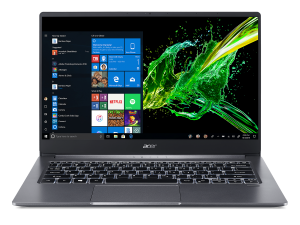

For every test like this, we use the same video in HD.


CPU options
Our unit features the Intel Pentium Silver N5030. It is part of the Gemini Lake refresh family and has four cores and four threads. Its rated TDP is 6W and it packs 4MB of cache memory. While the Base frequency is pretty low at 1.10 GHz, it packs quite the punch at short-term tasks thanks to the “Burst” clock of 3.10 GHz.
| CPU Benchmarks | single/multi Geekbench 5 | PCMark Computer Vision | Octane V2 | Mozilla Kraken 1.1 |
|---|---|---|---|---|
| Acer Chromebook 314 (C933) | 531/1655 | 9027 | 21011 | 1988.7 ms |
| Acer Chromebook Spin 11 (CP311-2H) | 378/1281 | 7122 | 15505 | 2457.7 ms |
GPU options
While this device lacks a dedicated GPU, the Pentium Silver N5030 has an integrated GPU called the Intel UHD Graphics 605. It has a base frequency of 200 MHz but the 750 MHz “Burst” clock is what you’ll get when playing games.
| GPU Benchmarks | 3DMark Slingshot | GFXBench Manhattan 3.0 (1080p offscreen) | GFXBench Manhattan 3.1 (1080p offscreen) | GFXBench Aztec Ruins OpenGL (1080p offscreen) |
|---|---|---|---|---|
| Acer Chromebook 314 (C933) | 2430 | 20 fps | 16 fps | 11 fps |
| Acer Chromebook Spin 11 (CP311-2H) | 2613 | 22 fps | 16 fps | 11 fps |
Temperatures and comfort
In order to stress out the machine we used a neat free app on the Play Store called CPU Throttling Test. Ultimately, it simulates a 100% load on the CPU, thus heating it as much as possible. We monitored a 42C maximum temperature on the keyboard deck. While this is a little warm we should consider that this is an extreme condition, and the Chromebook would never heat up as much in daily tasks. Additionally, the device is completely silent, thanks to the lack of a cooling fan and a mechanical drive.


Verdict
Actually, the Chromebook 314 (C933) was quite nice to use on a day-to-day basis. While it has all of the perks of a laptop, like a dedicated keyboard, large display, comfortable form factor and more, it is actually more like a big Android smartphone with enhanced multitasking abilities.
While the keyboard is pretty decent, we found the touchpad to be a bit unnatural to use. Of course, this might be from the way Chrome OS interacts with a tracking device, but honestly, it’s petty given the relatively large size it has.
Speaking of sizes, the Chromebook 314 (C933) has a very familiar form factor. It resembles some features of the Swift 3 (SF314-56) series. However, they are only limited to the shape of the notebook, as the former is made entirely out of plastic, has a relatively heavy body for a 14-incher and it definitely lacks some of the perks on the inside.
We say that because the Chromebook lacks upgradable memory and storage. On the bright side, it is equipped with 8GB of LPDDR4 memory. However, 64GB of eMMC storage is not great. Thankfully, you have the option of expanding it via the MicroSD card slot.
Acer Chromebook 314 (C933)’s display has a touchscreen IPS panel with a Full HD resolution, comfortable viewing angles and good contrast ratio. Also, it’s backlight isn’t flickering at any brightness level. Sadly, it covers only 50% of sRGB.
We should also mention the great battery life we got from the notebook. During Web browsing, the 50Wh unit lasted for almost 16 hours of continuous use, while video playback will set you in for 8 hours and 40 minutes. Indeed, the 6W TDP of the processor works well in conjunction with the large battery outfit.
At the end of the day, the Chromebook 314 (C933) is great for most of the people who need a companion to write e-mails and watch a movie or two after work. Forget about performance runs, though.
Pros
- Quick through the menu
- The OS loads in an instant
- Two USB Type-C ports that charge the laptop and can output DisplayPort
- Its display has comfortable viewing angles and good contrast ratio (BOE BOE07A0)
- Doesn’t use PWM to adjust screen brightness (BOE BOE07A0)
- MicroSD card storage expansion and LTE connectivity
Cons
- Touchpad feels weird
- Covers only 50% of sRGB
- Memory and storage are soldered to the motherboard
You can check the prices and configurations in our Specs System: https://laptopmedia.com/series/acer-chromebook-314-c933/
Also, you can check the current price of Acer Chromebook 314 (C933) here: Buy from Amazon.com (#CommissionsEarned)
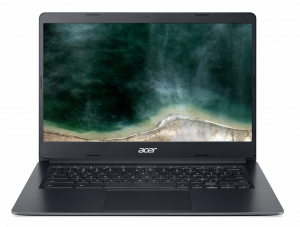




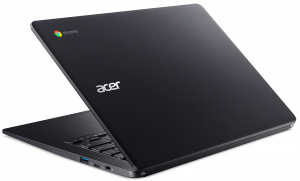

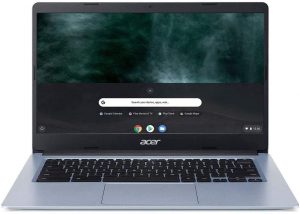
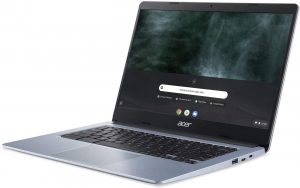
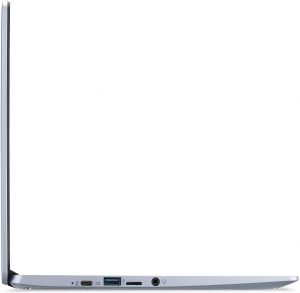
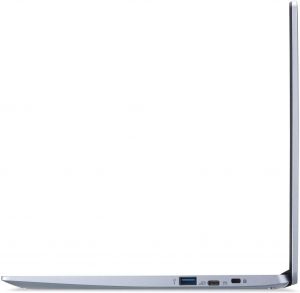
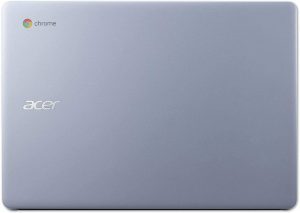
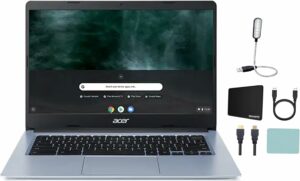
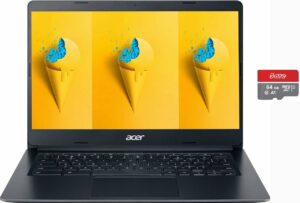

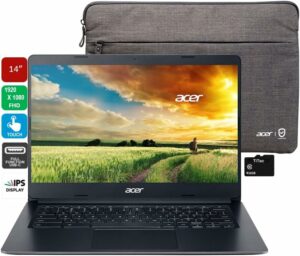
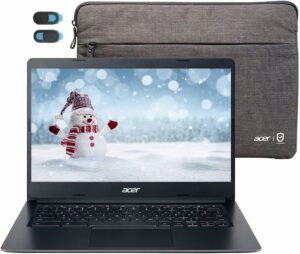
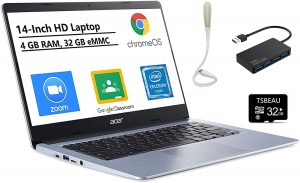









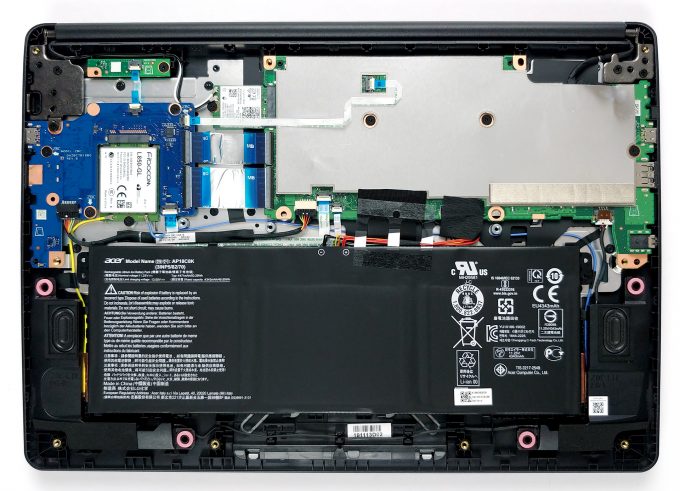
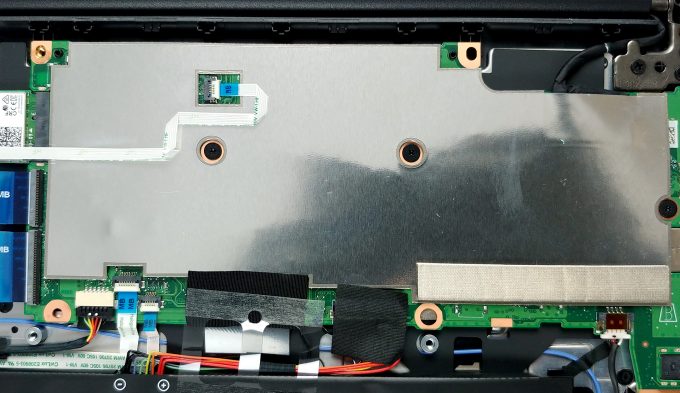
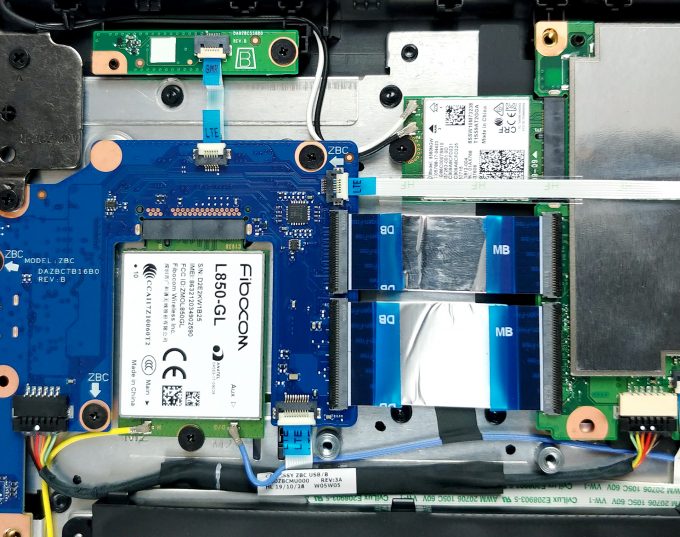
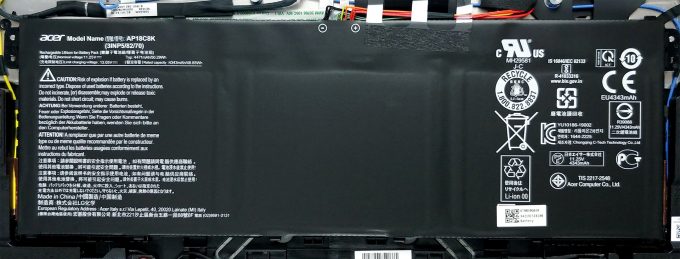


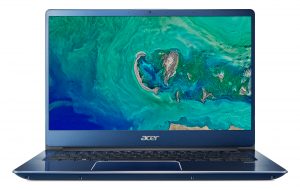








Hi Alex and Kroum – How does this Acer 314 C933-C7GM perform when using Zoom or other videoconferencing platforms? This is mainly what I want it for, other than email, browsing the web, some word processing/Google docs work, and occasional movies or youtube videos. Would this be a good choice for me? I like the price! Thanks. Peter.